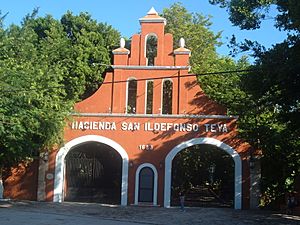Hacienda San Ildefonso Teya facts for kids
Quick facts for kids
Hacienda San Ildefonso Teya
|
|
|---|---|
|
Hotel / Restaurant
|
|

Entrance Hacienda Teya, Yucatán.
|
|
| Country | Mexico |
| Mexican States | Yucatán |
| Municipalities | Kanasín Municipality |
| Time zone | UTC−6 (CST) |
| • Summer (DST) | UTC−5 (CDT) |
| Postal code |
97650
|
| Area code | 991 |
Hacienda San Ildefonso Teya, also known as Hacienda Teya, is a famous place in the Kanasín Municipality of Yucatán, Mexico. This historic estate was once a huge cattle ranch in the 1600s. Later, it became important for growing henequen, a plant used to make rope. Today, Hacienda Teya has been beautifully restored and works as a hotel, restaurant, and a fun place for tourists to visit.
Contents
What Does "Teya" Mean?
The name "San Ildefonso Teya" comes from two languages: Spanish and the Mayan language.
- San Ildefonso is the name of a saint. The chapel at the hacienda is named after him.
- Teya is the Maya word for the sapadilla tree, also known as Manilkara zapota.
How to Visit Hacienda Teya
Hacienda Teya is easy to find! It's located just off the main Mérida-Cancún highway. Look for it around Kilometer 12.5.
A Look Back: History of Hacienda Teya
Hacienda Teya was started in 1683 by a woman named Ildefonsa Antonia Marcos Bermejo Calderón y de la Helguera. She was the wife of the Count of Miraflores. For about 200 years, the hacienda was a large farm where they raised livestock.
From Cattle to Henequen Farming
After being a cattle ranch, Hacienda Teya began growing corn. Later, it became a key part of the henequen industry. In the 1600s, Teya and another hacienda called Nohpat were the biggest and most successful haciendas in Yucatán.
Changes in Ownership
Over the years, the hacienda changed hands many times.
- In 1874, Manuel Ávila, the owner, passed away, and Joaquín Mendiola took over.
- By 1915, the owner, Alfredo Medina, was asked to give some land to the local community. This land was for people in Kanasín who needed plots to grow their own food or collect firewood.
Restoration and New Life
Hacienda Teya was left empty for a while. But in 1974, a man named Jorge Cárdenas Gutiérrez bought it. From 1987 to 1991, Mr. Cárdenas worked hard to rebuild and restore the property. He turned it into the beautiful hotel and restaurant it is today.
Architecture and Design
Hacienda San Ildefonso Teya still looks like a grand colonial estate. It also has some newer, elegant styles called neoclassical touches.
Key Features of the Hacienda
- The main house has a wide staircase at the entrance. It's framed by two beautiful arches. You'll see this arch design inside the house and at the entrance to the main courtyard too.
- The old dungeon has been changed into a wine cellar.
- The building that used to be the powerhouse is now a large ballroom, perfect for events.
- There are two chapels: a small one dedicated to San Antonio and a larger one used for celebrations and church services.
A Walk Through History
As you walk through the hacienda's hallways, you'll see an amazing collection of photographs. These pictures show the history of the home over the last century. Some photos even show what the hacienda looked like before and after its big renovation!
Population Changes in Teya
Before 1937, many people lived and worked on the henequen plantations. However, a land reform program in 1937 changed things. This program, led by President Lazaro Cardenas, turned the large haciendas into collective farms called ejidos. The original landowners could only keep a small part of their property (about 150 hectares).
Population Figures Over Time
After 1937, the population numbers mostly refer to people living in the community nearby. The hacienda itself only housed the owner's family. According to a 2005 census, the community had 554 residents.
| Year | 1900 | 1910 | 1921 | 1930 | 1940 | 1950 | 1960 | 1970 | 1980 | 1990 | 1995 | 2000 | 2005 |
|---|---|---|---|---|---|---|---|---|---|---|---|---|---|
| Population | 221 | 104 | 81 | 147 | 163 | 173 | 213 | 294 | 301 | 359 | 432 | 469 | 554 |
Images for kids
See also

- In Spanish: Hacienda Teya para niños




